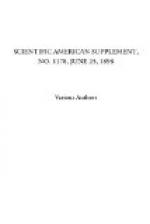early time is indeed amazing. Reclining lions,
hunting dogs and fish are so skillfully reproduced
that one asks how many centuries of development must
have preceded before the art of carving reached this
perfection. A number of feet taken from the legs
of small chairs and other similar furniture, and made
in imitation of bulls’ legs, show such a fixity
of style and at the same time such a freedom of execution,
that no archaeologist, without the report of the excavator,
would dare to proclaim them the oldest dated works
of Egyptian art. But it was not only in carving
ivory, which is easy to work, that the Egyptian artists
showed their skill. They also make bowls and vases
of diorite and porphyry with the same success; and
the forms presented by the smaller ivory vases are
also to be found in vases made of those refractory
stones. Further, the vases made of stone present
not merely such forms as might be made by turning
or boring, but there are also bowls with ribs which
are as finely polished as the turned bowls. The
hardest material used in the objects already found
is rock crystal, of which several small flasks and
bowls and a little lion are composed. But the
lion, it must be confessed, is rather rudely worked.
A few small vases of obsidian also occur—remarkable
in view of the fact that we do not know of any place
in or near Egypt where this stone may be found.
Besides these vessels of hard stone, there are, of
course, a large number made of softer stone.
Alabaster vases occur in every conceivable form.
Cylindrical pots, with wavy handles or simple cordlike
ornamentation, appear to have been especially favored.
The great beer jars, closed with enormous stoppers
of unbaked clay, were made of ordinary baked clay.
Of course the different stone and clay vessels, which,
undoubtedly, originally contained offerings for the
dead, form the bulk of the contents of the grave.
The slate tablets for rubbing cosmetics for painting
the body, and the flint weapons and knives of all
sorts, follow in point of numbers. Remarkably
enough, metal objects occur in this oldest historical
period alongside the stone implements, though, of
course, in less numbers. Several objects made
of copper and a slender bead of gold have been found.
Such, in short, is all that remains of the things
put in the tomb with the king. But little as
there is, it gives us an idea of the richness and
splendor with which these old royal tombs were furnished.
It might certainly be productive of unusual emotions to know that the few human bones found in the tomb, and now preserved in the Gizeh Museum, once belonged to the oldest Egyptian king. But as we know almost nothing of him, except some unfounded traditions, this sort of relic worship deserves very little respect. The scientific value of the proof that Menes was the king buried in the royal tomb of Neggadeh lies rather in the fact that we have now settled the question of the age of that culture which was presented to us




